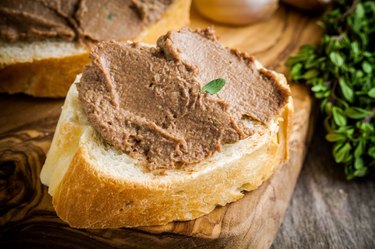
Duck liver, commonly called foie gras, is a delicacy made by force feeding cornmeal to ducks in a process known as gavage in an effort to make their livers larger and richer. This food is not without controversy, as some feel this amounts to animal cruelty. There has been some movement by cities and states to curtail both the production and sale of this food, although the American Veterinary Medical Association maintains that gavage may be performed humanely. Regardless of the controversy, duck liver offers much in the way of nutrition.
Calories and Fat
Video of the Day
A 44-gram serving of duck liver -- approximately 1.5 oz. -- contains 59.8 calories, as well as 2 g of fat. This amount of fat comprises 30 percent of the calories per serving. The amount of fat may vary, depending on the length of gavage; the longer a duck undergoes this process, the fattier the liver becomes. Best practice limits your fat intake to 44 to 78 g per day, or 20 to 35 percent of your total caloric intake. Consider serving a portion of duck liver with both a vegetable and grain, such as farro or wild rice, to consume a balanced meal.
Video of the Day
Cholesterol
Duck liver is high in cholesterol, which is not surprising considering the liver makes this substance. A 44-g duck liver contains 226.2 mg of cholesterol, satisfying nearly your entire daily allowance -- the Mayo Clinic recommends limiting consumption of cholesterol to 300 mg per day, although the American Heart Association suggests consuming 200 mg or less if you have heart disease. Your body produces all the cholesterol you need, and dietary cholesterol serves no purpose other than to clog arteries -- this fat does not dissolve in blood and may build up and block arterial blood flow. This puts you at greater risk of heart attack. If you include duck liver in your meal plan, carefully monitor your meal plan to avoid consuming too much cholesterol.
Protein and Carbohydrates
One portion of duck liver contains 1.6 g of carbohydrates. Because this macronutrient serves as your body's main source of energy, and you need 130 g of carbohydrates in your daily meal plan -- be sure to include other carbohydrate-rich foods in your diet to meet those needs. A 44-g duck liver provides you with 8.2 g of high-quality protein, as well. Protein from animal sources, such as duck liver, contain all nine essential amino acids that influence the state of your body's proteins. The protein you consume helps you build muscle, repair cells and tissues, maintain your immune function and serve as a secondary energy supply.
Minerals
A 44-g serving of duck liver serves as an excellent source of copper -- 131.2 percent of the daily recommended intake. Along with iron -- a serving of duck liver contains 74.6 percent of the amount you need in a day -- this makes duck liver a super food for your red blood cells. Both copper and iron help make up these cells. Copper also plays a role in the health of your blood vessels, bones, nerves and immune system. Eating duck liver also boosts your selenium intake; a portion of duck liver provides you with 42.1 percent of the daily recommended value. Your body needs selenium to make antioxidants that ward off cellular damage caused by free radicals.
Vitamins
Including duck liver in your diet provides an abundance of vitamin A. A 44-g portion contains 351.2 percent of the amount your body requires daily. Vitamin A is critical for the health of your eyes. An article in the October 2010 edition of "The Telegraph" reports that drugs derived from vitamin A may stop age-related macular degeneration, and this vitamin also influences the strength of your night vision. Duck liver also provides 396 percent of the daily recommended intake of vitamin B-12. This vitamin contributes to duck liver's benefits for your red blood cells, helping in their formation, as well as aiding in the function of your nerves.
Is this an emergency? If you are experiencing serious medical symptoms, please see the National Library of Medicine’s list of signs you need emergency medical attention or call 911.